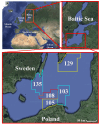Well-Being of the Baltic Herring and Bycatch Fish Species from FAO Major Fishing Areas 27 According to Microplastic Pollution
- PMID: 40867710
- PMCID: PMC12382631
- DOI: 10.3390/ani15162381
Well-Being of the Baltic Herring and Bycatch Fish Species from FAO Major Fishing Areas 27 According to Microplastic Pollution
Abstract
Condition factors are essential in fishery science. They provide insights into fish well-being according to the impact of environmental stressors. The Fulton condition factor (K) and hepatosomatic index (HSI), as well as two new indices (GILSI and GITI), were used to assess the well-being of herring and bycatch species (cod, flounder, sprat, long-spined bullhead, lumpfish) from the Baltic Sea. For Cyclopterus lumpus and Taurulus bubalis, K and HSI values were reported for the first time. Fish from different basins differed according to biometric measures (weight: 6.09-750.12 g; length: 8.6-41.8 mm) and condition indices (mean K: 1.19; HSI: 0.02; GITI: 0.04; GILSI: 0.03). Microplastics (MPs) were found in all species (21% (sprat)-79% (lumpfish)), averaging 3.1 items/fish. The organ-wise analysis revealed that 46% of the gills, 16% of the livers, and 38% of the gastrointestinal tracts were contaminated with MPs. The relationship between these indices and MPs abundance in the organs of herring was examined using PCA, revealing a negative impact of MPs on fish health. The morphometric features and the chemical composition of MPs were also detected. The dominant size ranges were 0.11-0.5 mm (30%) and 1.01-5 mm (28%). Blue fibers were the most common.
Keywords: Baltic cod; biometric features; flounder; long-spined bullhead; lumpfish; pollution with microplastics; principal component analysis; sprat; the Baltic Sea.
Conflict of interest statement
The authors declare no conflicts of interest.
Figures






Similar articles
-
Prescription of Controlled Substances: Benefits and Risks.2025 Jul 6. In: StatPearls [Internet]. Treasure Island (FL): StatPearls Publishing; 2025 Jan–. 2025 Jul 6. In: StatPearls [Internet]. Treasure Island (FL): StatPearls Publishing; 2025 Jan–. PMID: 30726003 Free Books & Documents.
-
Microplastic ingestion in wild zoanthids: first evidence and a global meta-analysis on cnidarian.Environ Monit Assess. 2025 Aug 13;197(9):1013. doi: 10.1007/s10661-025-14470-z. Environ Monit Assess. 2025. PMID: 40802122
-
Microplastic Distribution Patterns in Fish and Implications for Safe Consumption.Environ Sci Technol. 2025 Aug 26;59(33):17393-17402. doi: 10.1021/acs.est.5c02907. Epub 2025 Aug 14. Environ Sci Technol. 2025. PMID: 40810570
-
A rapid and systematic review of the clinical effectiveness and cost-effectiveness of paclitaxel, docetaxel, gemcitabine and vinorelbine in non-small-cell lung cancer.Health Technol Assess. 2001;5(32):1-195. doi: 10.3310/hta5320. Health Technol Assess. 2001. PMID: 12065068
-
Systemic pharmacological treatments for chronic plaque psoriasis: a network meta-analysis.Cochrane Database Syst Rev. 2021 Apr 19;4(4):CD011535. doi: 10.1002/14651858.CD011535.pub4. Cochrane Database Syst Rev. 2021. Update in: Cochrane Database Syst Rev. 2022 May 23;5:CD011535. doi: 10.1002/14651858.CD011535.pub5. PMID: 33871055 Free PMC article. Updated.
References
-
- Holmlund C., Hammer M. Ecological ecosystem services generated by fish populations. Ecol. Econ. 1999;29:253–268. doi: 10.1016/S0921-8009(99)00015-4. - DOI
-
- Sterner R.W., Elser J.J. Ecological Stoichiometry: The Biology of Elements from Molecules to the Biosphere. Princeton University Press; Princeton, NJ, USA: 2002. Stoichiometry and homeostasis; pp. 1–43. - DOI
-
- Schiettekatte N.M.D., Casey J.M., Brandl S.J., Mercière A., Degregori S., Burkepile D., Van Wert J.C., Ghilardi M., Villéger S., Parravicini V. The role of fish feces for nutrient cycling on coral reefs. Oikos. 2023;9:e09914. doi: 10.1111/oik.09914. - DOI
-
- Whitfield A.K. Fishes and the environmental status of South African estuaries. Fish. Manag. Ecol. 1996;3:45–57. doi: 10.1111/j.1365-2400.1996.tb00129.x. - DOI
Grants and funding
LinkOut - more resources
Full Text Sources

